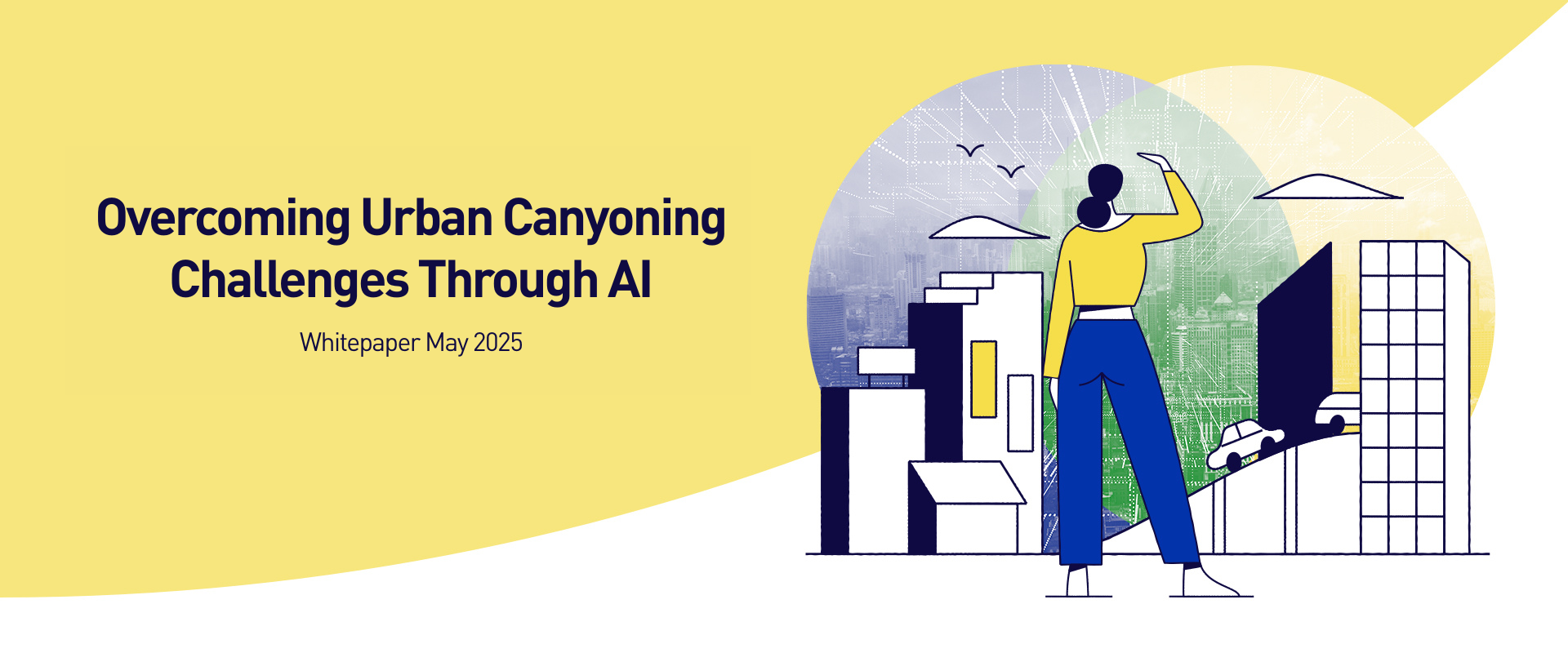Why Urban Canyoning Is a Strategic Problem for Smart Cities - And What AI Can Do About It
Why Urban Canyoning Is a Strategic Problem for Smart Cities - And What AI Can Do About It


As cities become denser, taller, and more dynamic, urban planning is shifting from infrastructure development to systems optimisation. But while much attention has been paid to high-level strategies like decarbonisation and public transport upgrades, one persistent challenge continues to undermine day-to-day operations: urban canyoning.
This isn’t a fringe concern for technologists. It’s a strategic blind spot for city managers. When tall buildings disrupt GPS signals and obstruct visibility, the result is a breakdown in location accuracy, enforcement effectiveness, and public service delivery. From a systems perspective, urban canyoning isn’t just a technical hiccup—it’s a cascading failure point that ripples across multiple functions of a smart city.
As cities become denser, taller, and more dynamic, urban planning is shifting from infrastructure development to systems optimisation. But while much attention has been paid to high-level strategies like decarbonisation and public transport upgrades, one persistent challenge continues to undermine day-to-day operations: urban canyoning.
This isn’t a fringe concern for technologists. It’s a strategic blind spot for city managers. When tall buildings disrupt GPS signals and obstruct visibility, the result is a breakdown in location accuracy, enforcement effectiveness, and public service delivery. From a systems perspective, urban canyoning isn’t just a technical hiccup—it’s a cascading failure point that ripples across multiple functions of a smart city.
Visibility Isn’t Just Visual - It’s Operational
Visibility Isn’t Just Visual - It’s Operational
Urban canyoning reduces visibility in more than just the literal sense. Inaccurate geolocation data affects how cities make decisions and allocate resources. Think about parking compliance: if a city can’t reliably locate where a vehicle is parked, enforcement becomes inconsistent, and public trust in the system erodes. But beyond parking, this same problem affects emergency services, public transport routing, delivery logistics, and even environmental monitoring.
It creates a dual burden: on the one hand, the city must invest more human labour into areas where automation fails (like sending officers on foot instead of using vehicles); on the other, the data being generated from those efforts becomes less reliable, reducing its usefulness for long-term planning.
Urban canyoning reduces visibility in more than just the literal sense. Inaccurate geolocation data affects how cities make decisions and allocate resources. Think about parking compliance: if a city can’t reliably locate where a vehicle is parked, enforcement becomes inconsistent, and public trust in the system erodes. But beyond parking, this same problem affects emergency services, public transport routing, delivery logistics, and even environmental monitoring.
It creates a dual burden: on the one hand, the city must invest more human labour into areas where automation fails (like sending officers on foot instead of using vehicles); on the other, the data being generated from those efforts becomes less reliable, reducing its usefulness for long-term planning.
The Invisibility of Urban Inefficiency
The Invisibility of Urban Inefficiency
What makes urban canyoning especially difficult to manage is its invisibility at the leadership level. It doesn’t show up as a line item in budget forecasts, and it’s not easily recognised in public consultation processes. Instead, it emerges as a pattern of inefficiencies: slower response times, rising operational costs, or increases in complaints about parking fines that can’t be verified.
Because these symptoms are often misattributed to poor enforcement or outdated infrastructure, cities tend to reach for expensive fixes: more cameras, new patrol routes, or blanket investments in GPS-based technologies that ultimately fail in the very areas where they’re most needed.
That’s why a shift in thinking is required—not toward more infrastructure, but toward smarter interpretation of existing data. And that’s where artificial intelligence becomes essential.
What makes urban canyoning especially difficult to manage is its invisibility at the leadership level. It doesn’t show up as a line item in budget forecasts, and it’s not easily recognised in public consultation processes. Instead, it emerges as a pattern of inefficiencies: slower response times, rising operational costs, or increases in complaints about parking fines that can’t be verified.
Because these symptoms are often misattributed to poor enforcement or outdated infrastructure, cities tend to reach for expensive fixes: more cameras, new patrol routes, or blanket investments in GPS-based technologies that ultimately fail in the very areas where they’re most needed.
That’s why a shift in thinking is required—not toward more infrastructure, but toward smarter interpretation of existing data. And that’s where artificial intelligence becomes essential.
AI as a Lens, Not Just a Tool
AI as a Lens, Not Just a Tool
The real promise of AI in the urban environment isn’t just in automation—it’s in situational clarity. Systems like SenSen’s Environmental Mapping Technology (EMT) don’t just fill in GPS gaps—they reimagine how spatial data is collected and interpreted. By fusing visual recognition, municipal infrastructure records, and transactional data from parking systems, these AI platforms offer an augmented perspective on urban reality.
It’s a subtle but important difference: traditional systems try to correct GPS inaccuracies; AI systems question whether GPS is even the best input to start with.
The result is more than technical accuracy—it’s institutional confidence. City managers can now enforce rules without fear of error, and frontline officers can shift from reactive roles to strategic oversight. This is the true “AI for Good” moment—not replacing humans, but enabling them to do higher-value work with better information.
The real promise of AI in the urban environment isn’t just in automation—it’s in situational clarity. Systems like SenSen’s Environmental Mapping Technology (EMT) don’t just fill in GPS gaps—they reimagine how spatial data is collected and interpreted. By fusing visual recognition, municipal infrastructure records, and transactional data from parking systems, these AI platforms offer an augmented perspective on urban reality.
It’s a subtle but important difference: traditional systems try to correct GPS inaccuracies; AI systems question whether GPS is even the best input to start with.
The result is more than technical accuracy—it’s institutional confidence. City managers can now enforce rules without fear of error, and frontline officers can shift from reactive roles to strategic oversight. This is the true “AI for Good” moment—not replacing humans, but enabling them to do higher-value work with better information.
From Tactical Fix to Strategic Enabler
From Tactical Fix to Strategic Enabler
The adoption of AI to overcome urban canyoning has already begun, with Brisbane City Council showing what’s possible when you apply smart tech to a stubbornly analog problem. But the implications go much further. Once you solve for geolocation accuracy in dense urban zones, you open the door to:
- Dynamic road pricing and congestion control
- Safe rollout of micromobility and autonomous vehicles
- Real-time emissions tracking linked to vehicle movement
- Data-informed responses to major events like festivals or the Olympics
In this light, solving urban canyoning isn’t just a technology choice—it’s a prerequisite for smart city readiness.
The adoption of AI to overcome urban canyoning has already begun, with Brisbane City Council showing what’s possible when you apply smart tech to a stubbornly analog problem. But the implications go much further. Once you solve for geolocation accuracy in dense urban zones, you open the door to:
- Dynamic road pricing and congestion control
- Safe rollout of micromobility and autonomous vehicles
- Real-time emissions tracking linked to vehicle movement
- Data-informed responses to major events like festivals or the Olympics
In this light, solving urban canyoning isn’t just a technology choice—it’s a prerequisite for smart city readiness.
Bridging the Gap Between Urban Form and Digital Function
Bridging the Gap Between Urban Form and Digital Function
Cities around the world are investing heavily in smart technologies, but without addressing foundational challenges like urban canyoning, many of these investments will underdeliver. It’s not enough to be digitally ambitious if the data you rely on is structurally flawed.
By taking a system-level view—and treating location integrity as a strategic priority—cities can unlock powerful new capabilities. AI isn’t just about what you can automate. It’s about what you can now see clearly for the first time.
Want to explore the full implications of AI-powered location accuracy? Download the white paper: Overcoming Urban Canyoning Challenges Through AI
Cities around the world are investing heavily in smart technologies, but without addressing foundational challenges like urban canyoning, many of these investments will underdeliver. It’s not enough to be digitally ambitious if the data you rely on is structurally flawed.
By taking a system-level view—and treating location integrity as a strategic priority—cities can unlock powerful new capabilities. AI isn’t just about what you can automate. It’s about what you can now see clearly for the first time.
Want to explore the full implications of AI-powered location accuracy? Download the white paper: Overcoming Urban Canyoning Challenges Through AI

